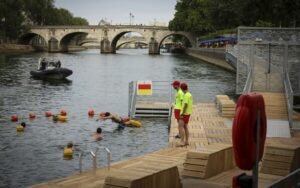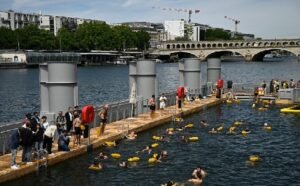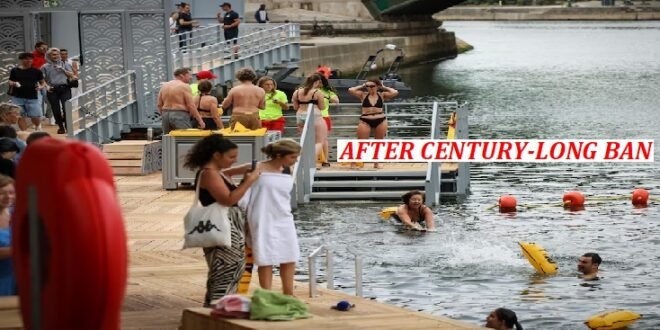08-07-2025
PARIS: The River Seine in Paris has reopened publicly to swimmers for the first time since 1923 after a century-long ban.
The seasonal opening of the Seine for swimming is viewed as a key legacy of the Paris 2024 Olympics, when open water swimmers and triathletes competed in its waters which were specially cleaned for the event.
 On Saturday morning at 08:00 local time (07:00 BST) a few dozen swimmers arrived ahead of the opening and dived into the water when they were able to do so.
On Saturday morning at 08:00 local time (07:00 BST) a few dozen swimmers arrived ahead of the opening and dived into the water when they were able to do so.
There are three designated areas for public swimming in the Seine – one near the Eiffel Tower, another close to Notre Dame Cathedral and a third in eastern Paris.
Zones have changing rooms, showers, and beach-style furniture, which allow for up to 300 people to lay out their towels.
Until the end of August, the three swimming sites will be open for free at scheduled times to anyone with a minimum age of 10 or 14 years, depending on the location.
Lifeguards will also be present keeping an eye on those in the river.
The promise to lift the swimming ban dates back to 1988, when then-mayor of Paris and future president Jacques Chirac first advocated for its reversal.
Improvements over the last 20 years have already led to a sharp reduction in faecal bacteria entering the river.
For 100 years swimming was banned in the river because of the levels of water pollution that could make people ill.
Ahead of last summer’s Olympics more than €1.4bn (£1.2bn; $1.6bn) was invested into cleaning up the Seine but, in the lead up to the games there were doubts as to whether the River Seine would be ready for the Olympics after it was revealed it failed water quality tests.
Organizers blamed rainfall for the increased pollution which limited athletes’ abilities to train for the triathlon, marathon swimming and paratriathlon.
 Last July, Paris Mayor Anne Hidalgo and other members of the Olympic committee went into the Seine to prove that it was safe to swim in.
Last July, Paris Mayor Anne Hidalgo and other members of the Olympic committee went into the Seine to prove that it was safe to swim in.
The Seine River, central to Paris’s history, has played a vital role in the city’s development and culture for over two millennia. Its course has shaped Paris, with many iconic landmarks situated along its banks, and it has been a source of life, trade and even recreation for the city’s inhabitants.
The Seine’s origins are ancient, with evidence of human presence along its banks dating back to Neolithic times.
The Celtic tribe, the Parisii, established a settlement on the Ile de la Cite, an island in the Seine, which eventually grew into the city of Paris.
The Romans, recognizing the river’s strategic importance, expanded trade and fortified settlements along the Seine, including the city of Lutetia, the forerunner of Paris.
The Seine remained a crucial trading route, connecting Paris to the English Channel and inland regions like Dijon.
Paris grew into a major city and trading center by the 12th century, largely due to its location on the Seine.
The river was also a site for bathing, with early forms of bathing establishments like floating bathhouses emerging.
The Seine has been a source of both beauty and industry for Paris. Stone quays were built along the river for beautification and practical purposes like flood control.
The river has witnessed numerous floods throughout history, with the 1910 flood being particularly devastating, causing widespread damage and requiring Parisians to navigate the city by boat. (Int’l Monitoring Desk)
 Pressmediaofindia
Pressmediaofindia




